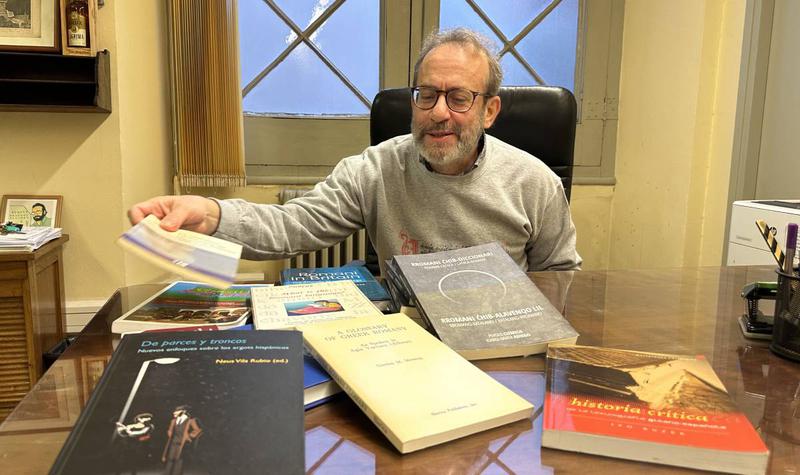The journey of a language: Origin and evolution of Romani
From India to Unesco to the living rooms of Catalonia, the language of the Roma people has traveled far

In an office on the first floor of the University of Barcelona's historic building, Ignasi-Xavier Adiego, a professor in Indo-European linguistics sits at his dark brown desk. Since the early 2000s, he has been studying Romani, the language of the Roma people, and in particular, Caló, the dialect spoken in Catalonia and Spain.
On the table in front of him are books about the language. Some he has written, like the Romani-Catalan dictionary from 2022, and others by other authors that are "really good." One of the books asks, 'What is the Romani language?' in the title.
"The Romani language belongs to the Indo-Iranian linguistic family, or more specifically, the Indo-Aryan family, which is the scientific terminology," he says. "This may sound bad to some, but it refers to a series of languages spoken in India that derive from Sanskrit, the classical language of India."
A language of many layers
The Sanskrit origin of Romani explains the journey and history of the Romani people, according to the linguist: "I always compare the Romani language to an onion that has many layers," he says. "For example, we can find loan words from the Iranian languages, from Armenian, and later, primarily from Greek."
It is through these linguistic analyses that linguists like Adiego have been able to reconstruct the journey of the Roma people from India, through Central Asia before arriving in Europe in the 16th century. "By peeling back the layers of the onion we find this journey," he says.
Caló, the Iberian variation
As the Roma people settled down in the regions they passed, a linguistic exchange between Romani and the majority languages of the regions it came into contact with occurred, and so dialects and variations of Romani developed, some of which were and are not mutually intelligible.
The variation of Romani that developed in Catalonia and Spain is Caló. In linguistic terms, Caló is a Para-Romani dialect, which means that the vocabulary has a Romani origin while the grammar has adopted Catalan and Spanish traits such as verb conjugations.
According to Adiego, the linguistic influence Caló has had on Spanish and Catalan is most evident in the everyday colloquial language. Words like calés (slang for money), jalar (to eat, in English), or xaval (Catalan slang for 'dude') all come from Caló and are used commonly in Catalan.
Unknown number of speakers
Adiego estimates that there are around 600,000 to 700,000 people of Roma origin in Spain, but only a few speak Caló, although it is difficult to determine an exact number for several reasons.
"First of all, these are languages that aren't officially recognized, which means that the speakers are not registered. And sometimes, the Roma people have to hide their identity because of the terrible persecution they have suffered," he says. Caló and other Romani languages were prohibited during the Francoist dictatorship in Spain.
As a result, the use of Caló among Catalan Romas has been suffering a steady decline that has only accelerated over the last 30 years. "Many Catalan and Spanish Romas have very limited knowledge of the language today," explains Adiego, adding that many from the young generations haven't learned it or only use it very sporadically.
"In a language like Caló, where the vocabulary is what distinguishes it from majority languages like Catalan or Spanish, if the vocabulary is lost, the language is lost," he says. "I have observed that many Catalan Romas don't know words that are considered basic in a vocabulary like 'dad', 'mom,' or 'child'."
A push for a standardized Romani
While Caló has been in decline, for years there has been a push within the community to promote a standardized Romani language that could be spoken around the world by Roma people. The French linguist Marcel Courthiade proposed a standardization, which was adopted by the International Romani Union in Warsaw in 1990.
Later, in 2015, UNESCO proclaimed November 5 as World Day of the Romani Language, which aimed to promote and preserve the Romani language and culture.
Marinela Isuf is a Roma activist from Albania who grew up speaking Romani as her first language. For six years, she has been teaching Romani to school children in L'Hospitalet, near Barcelona, and her goal is to "recover our language and to teach the new generations."
"Our language is our identity, and with it, you can identify me as a Roma," she says. "When I meet other young Romas in Europe or America, we don't speak English, we speak Romani."
In Catalonia, Adiego co-published the first Catalan-Romani dictionary with Seo Ćizmić, honorary ambassador of the Romani language and director of Romanó Kher in 2022.
With this dictionary, Ćizmić hopes that Roma people will have the dictionary in their homes "when they want to learn a word or want to say something," while Adiego hopes that it can become a tool to communicate across country borders.
To learn more about the Romani language listen to the latest episode of our podcast Filling the Sink.